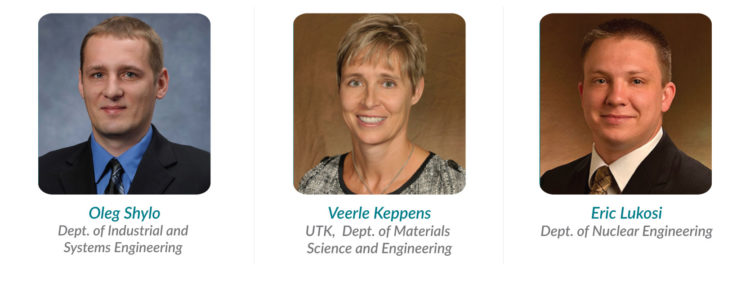 Article by the UT Office of Research and Engagement
Article by the UT Office of Research and Engagement
2017 Class of UT-ORNL Joint Directed Research and Development Faculty Named
Ten researchers were given Joint Directed Research Development (JDRD) awards for 2017 as part of the Science Alliance—a Tennessee Center of Excellence managed by the Office of Research and Engagement. The JDRD program was conceived to provide faculty members an opportunity to work collaboratively with researchers at Oak Ridge National Laboratory (ORNL).
JDRD awards are given to faculty across a wide range of disciplines and departments with the directive to collaborate with an ORNL Laboratory Directed Research Development (LDRD) project, an ORNL Seed Project, or a project that meets one of several strategic objectives. Awarded projects focus on a variety of research areas including advanced manufacturing, big data management, and climate change and adaptation.
“This year’s solicitation attracted 34 new proposals, half of which were submitted by assistant professors,” said Louise Nuttle, director of faculty development for ORE. “While the opportunity is available to all UT faculty, the high number of meritorious proposals received from junior faculty resulted in the funding of nine new collaborations, including eight from assistant professors.”
The 2017 list of awards is comprised of nine first-year proposals and one second-year project, including the following faculty members:
- Christopher Baker, Department of Chemistry – A Microfluidic droplet array sensor for the discovery of high value bioproducts in fungal cell cultures
- Jeremiah Johnson, Department of Microbiology – Epidemiological study of human campylobateriosis with the development of a microbial source-tracking database
- Veerle Keppens, Department of Materials Science and Engineering – Electronic and magnetic phase control of complex materials using ionic liquid gating
- Maik Lang, Department of Nuclear Engineering – Unrevealing short-range order in SiO2 glass under extreme conditions using the ORNL Integrated Computational Environmental-Modeling & Analysis for Neutrons (ICE-MAN)
- Eric Lukosi, Department of Nuclear Engineering – Microfluidic spectrometry for biomedical applications
- Sharani Roy, Department of Chemistry – Understanding complexity at reactive interfaces through theory and experiments
- Seungha Shin, Department of Mechanical, Aerospace , and Biomedical Engineering –Atomistic investigation of interfacial transport in aluminum alloys
- Oleg Shylo, Department of Industrial and Systems Engineering – Scalable communication models for parallel optimization
- Haixuan Xu, Department of Materials Science and Engineering – Radiation effects and defect properties in low-dimensional materials
- Zhili Zhang, Department of Mechanical, Aerospace and Biomedical Engineering – Real-time nonintrusive tomographic imaging of plasma facing components surface and subsurface erosions
The majority of the funded projects represent first-time ORNL collaborations.
The LDRD program at ORNL is funded by the US Department of Energy and encourages multiprogram DOE laboratories to select a limited number of projects with the potential to position the lab for scientific and technical leadership in future national initiatives.
The ORNL Seed Money Fund provides a source of funding for innovative ideas that have the potential to enhance the laboratory’s core scientific and technical competencies. The JDRD program identifies and supports corresponding areas of research at UT.
Proposals submitted to the JDRD program are evaluated on a range of criteria including whether they will include graduate and undergraduate students in the research. In 2016 alone, Science Alliance programs, including the JDRD program, provided funding and research opportunities for more than 120 graduate and undergraduate students across the university.
JDRD-awarded projects can be funded for up to two years with a progress assessment at the end of year one to determine if second-year funding will be given. Second-year funding is based on the development of the partnership and the research progress thus far.
Established in 1984, the Science Alliance mission is to expand cooperative ventures in research with ORNL and enhance science and engineering research programs at the UT. The center also provides support to several joint institutes, including the recently renamed Shull Wollan Center–A Joint Institute for Neutron Sciences.